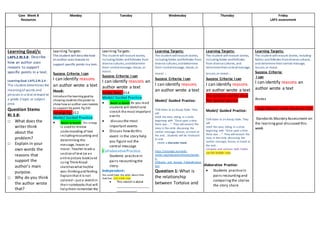
2 step math problems (1)
- 1. Core Week 8 Resources Monday Tuesday Wednesday Thursday Friday LAFS assessment Learning Goal/s: LAFS.2.RI.3.8: Describe how an author uses reasons to support specific points in a text. Learning Goal: LAFS.2.RI.2.4 - The student determines the meaningof words and phrases in a text relevant to a grade 2 topic or subject area. Question Stems RI.3.8: □ What does the writer think about the problem? □ Explain in your own words the reasons that support the author’s main purpose. □ Why do you think the author wrote that? Learning Targets: The student will describehow an author uses reasons to support specific points ina text. Success Criteria: I can I can identify reasons an author wrote a text Hook: Introducethelearning goalby showing students theposterto show how anauthor uses reasons to support his point. Pg 310 Earwigs Pg. 312 Model/ Guided Practice: Sketch to Stretch: This strategy is usedto review understanding of text includingrecounting and determining the message, lesson or moral. Teacher reads a sectionof text (or an entire picture book)and using ThinkAloud sketcheswhat he/she was thinkingandfeeling. Explainthat it is not colored– just a sketchin their notebooks that will helpthem remember the Learning Targets: The student willrecount stories, including fables andfolktales from diversecultures,anddetermine their centralmessage, lesson,or moral. Success Criteria: I can I can identify reasons an author wrote a text Solder Bees 314 Model/ Guided Practice: Sketch to Stretch As you read students will sketchand stretch the most important events discussthe most important events Discuss howdo this event in the story help you figure out the central message CollaborativePractice: Students practicein pairs recountingthe story. Independent: You could have the write about their sketches: Use a tree map This sketch is about _____________________ _____________. Learning Targets: The student willrecount stories, including fables andfolktales from diversecultures,anddetermine their centralmessage, lesson,or moral. . Success Criteria: I can I can identify reasons an author wrote a text Model/ Guided Practice: TSW listen to an Aesop fable. They will retell the story sitting in a circle, beginning with “Once upon a time there was ...”. They will recount the story in the circle discussing the central message, lesson, or moral at the end. . Students will be Itroduced to and create a character mask. https://artsedge.kennedy- center.org/educators/lessons/grade- k- 2/Masks_and_Aesops_Fables#Instruc tion Question 1: What is the relationship between Tortoise and Learning Targets: The student willrecount stories, including fables andfolktales from diversecultures, and determinetheircentralmessage, lesson, or moral.. Success Criteria: I can I can identify reasons an author wrote a text The tortoise and the Hare The second version Model/ Guided Practice: TSW listen to an Aesop fable. They will retell the story sitting in a circle, beginning with “Once upon a time there was ...”. They will recount the story in the circle discussing the central message, lesson, or moral at the end. . compare and contrast both Fables use the bubble map 328-329 “Turn Onthe ollaborative Practice: Students practicein pairs recountingand comparingthe stories the story share Learning Targets: The student willrecount stories, including fables and folktales fromdiversecultures, and determinetheircentral message, lesson, or moral. Success Criteria: I can I can identify reasons an author wrote a text Assess Bugs Nature’s time machine! 318 Standards Mastery Assessment on the learning goal discussed this week
- 2. □ What details did the author use to support his/her main purpose? □ Did the author justify his/her ideas? □ Why did the author write this piece? Academic Vocabulary (RI.3.8): • reasons • justify • explain • details • support • main purpose story. Have students hypothesize about your sketch/interpretationof the story. Explainyour thinking/sketching. discussthe most important events Discuss howdo this event in the story help you figure out the central message CollaborativePractice: Students practicein pairs recountingthe story. Independent: You could have the write about their sketches: Use a tree map This sketch is about __________________ ________________. I feel __________________ __________________ __________. I made a connection to __________________ ____________. The messagein the story was __________________ ______________. I feel _____________________ _____________________ ____. I made a connection to _____________________ _________. The messagein the story was _____________________ ___________. Hare? Look for evidence in the story. Question 2: How does Tortoise feel about the race? Look for evidence in the story. Question 3: How do the other animals feel about Hare? Look for evidence in the story. Question 4: How does the reader know Hare was convinced he would win the race? Look for evidence in the story. Question 5: What lesson does the author want the reader to learn from Tortoise? Look for evidence in the story. 328-329 “Turn Onthe Collaborative Practice: Students work tin pears based on the role. share
- 4. Differentiation/Accommodations ELL Strategies (indicate all that apply): Students: LA2-model read LA10-highlight text LA13-comprehensioncheck LA22- semantic webbing LA30-cooperative learning Other (click here for complete list) Use Graphic organizers andvisuals/picturesthroughout lesson/unit/assignment Allowextendedtime for test/project completion ESE Strategies (indicate all that apply): Student Initials handouts/studyguides visual aids peer support tasks explained insmall steps alternative assessment highlighters extendedtime Other: Dependent uponIEPGoals. Advanced Learner Strategies – Students: (indicate allthat apply): enrichment self-directedlearning Researchand Leadership independent readingand writingchoices Critical ThinkingSkills